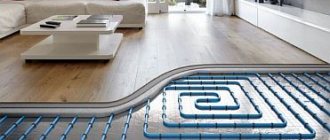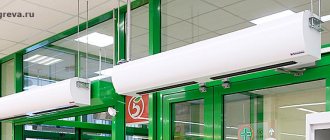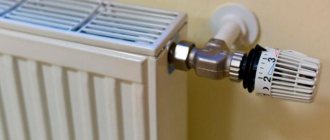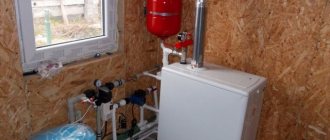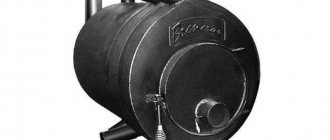The heating system is the most important component of the coziness and comfort of a living space, providing warmth even in severe cold. But in order for this system to be reliable and not fail at the most inopportune moment, every homeowner must make the right choice, giving preference to the most rational, acceptable heating option available on the market.
Today we will talk about the most popular version of a two-pipe heating system and reveal all its nuances and features, pros and cons, scope of application and principle of operation. So, let's get to work!
Categories of heating systems and operating principles
Space heating was invented by mankind 3000 years ago. Back in that distant era, ancient people used a system of pipes leading to hot water boilers to heat the palaces of influential people during the cold season. Today, a heating system is an essential attribute of modernity, offering a wide range of options.
There are two main categories of pipe heating systems: single-pipe and double-pipe.
The difference between the systems is as follows: a 1-pipe system operates on the principle of a closed ring. By circulating, the water passes through the boiler and imparts heat to the radiators, after which the cold water returns back. The 2-pipe heating principle consists of two circuits that distribute heat.
The type of system being installed will affect the size of the radiators and piping. It is also worth noting that the first option is more often used in small houses, while the second is used for large areas, for example, for heating cottages.
Advantages
- All radiators receive coolant at the same temperature
- You can install a thermostat on each radiator and maintain a comfortable temperature in each room, and this will not affect the operation of the entire system.
- Pressure loss is negligible
- The coolant flow on each radiator can be stopped and this will in no way affect the operation of the entire system. This plus allows you to carry out repair work without turning off the heating in the entire house or apartment.
- Can be installed and operated in a house of any size and number of floors.
Pros and cons of a 2-pipe system
The advantages of such heating include the following points:
- The system is more reliable and less vulnerable to defrosting;
- Parallel connection principle, providing greater heat output;
- Possibility of extension, both vertically and horizontally, which is especially convenient when expanding living space (extension of residential premises);
- Possibility of manual temperature control for each room.
The disadvantages include the following:
- Higher cost;
- Installation is somewhat more complicated;
- More consumables (pipes) will be required.
conclusions
The considered methods do not provide a complete guarantee of balancing, since they are based on general recommendations. However, as we all know, each system is individual, although it is equipped based on generally accepted rules. It all depends on the basic settings. If everything was done wisely from the very beginning, then maintenance will not cause difficulties. As practice shows, quick balancing , so be patient and consistent. And don't forget about specialized designs designed to speed up adjustments.
Varieties of 2-pipe system schemes
There are several variations of 2-pipe heating, each of which has its own nuances that should be taken into account when choosing.
Two-pipe direct return system
In a two-pipe direct return system, the total pipe length from the pump to each radiator is shorter for radiators closer to the pump and longer for radiators further away. For this reason, the pressure drop may be significantly higher at the nearest radiator than at the farthest radiator.
This must be taken into account when designing the system. The advantage of a direct return system is that pipe routing is easier compared to a reverse return system.
Two-pipe system with reverse return (Tichelman system)
In a two-pipe return system, the total length of pipe from the pump to each radiator is the same for all radiators on the same floor. This gives a favorable distribution of water.
Two-pipe system with top pipe
The distribution pipe is located in the suspended ceiling and the ventilation holes are installed in central positions. This type of system is common in large buildings as it is relatively easy to balance and adjust. It is also easy to expand the system.
Two-pipe system with floor piping
This system is very common in homes and buildings where piping cannot be installed in the accessible ceiling space. Distribution pipes are located under the floor. In multi-storey buildings, ventilation screws are required on radiators. Circulating, inline, single-stage pumps are commonly used for two-pipe heating systems in residential and commercial heating systems.
Adviсe
The expansion tank is located at or above the peak point of the main line. If there is an autonomous water supply, then it can be integrated with a supply tank. The slope of the supply and return pipes should be no more than 10 cm per 20 or more linear meters.
If the pipeline is at the front door, it is appropriate to divide it into two elbows. Then the wiring is created from the location of the highest point of the system. The lower line of a two-pipe structure must be symmetrical and parallel to the upper one.
All technological units must be equipped with taps, and it is advisable to insulate the supply pipe. It is also advisable to place the distribution tank in an insulated room. In this case, there should be no right angles, sharp breaks, which will subsequently create resistance and air pockets. Finally, we must not forget about the supports for the pipes - they must be made of steel and cut in every 1.2 meters.
Possible problems and solutions
Many buildings in large cities have existing one- and two-pipe steam heating systems.
Scheme of a two-pipe heating system
Both 1-pipe and 2-pipe systems have control problems from time to time, resulting in uneven heating, high fuel consumption and water hammer.
Let's now look at modern systems, best practices, and troubleshooting for maintaining a comfortable environment and saving energy.
Heating systems allow condensate and steam to move throughout the system within the same pipes.
As the boiler creates steam, it passes through the pipes and rises up to the radiators, where it heats the space and condenses. This condensate is then returned through the same pipe(s) back to the boiler.
The pipes and radiators are all sloped back towards the boiler to allow this system to operate by gravity.
For the system to work well, the steam flow must be balanced. Adjustable air valves must be installed on each radiator. Thus, radiators closest to the boiler may have a smaller opening on the air valve.
Radiators located further from the boiler may have a larger opening. This allows steam to flow more evenly throughout the system, as radiators closest to the boiler do not overheat, and radiators further away from the boiler do not overheat.
Expert opinion
Grebnev Vadim Savelievich
Heating system installer
Air valves can be used to shut off steam to unoccupied rooms. If the air valve is completely closed, no steam will flow into the radiator.
Air valves operate using a bellows filled with an alcohol-water mixture. The temperature is such that air can escape, but when steam is present at high temperature, it turns into gas, expanding the bellows which closes the valve. Air valves should be checked every three to five years as they can fail and are essential for the system to function properly.
Automatically adjustable air valves
They can be set to different temperatures from room to room. Although they are more expensive than simple air valves, they actually respond to subtle changes in temperature, not just the amount of steam in the radiator. The control is noticeably better and it is a higher quality product than simple air valves.
Characteristic
The most common is the two-pipe heating system, despite some advantages of single-pipe structures. No matter how complex such a pipeline with two pipes (separately for supplying water and returning it) may be, most people prefer it.
Such systems are installed in multi-storey and apartment buildings.
Device
The elements of dual-line heating with lower pipe insertion are as follows:
- boiler and pump;
- auto vent, thermostatic and safety valves, valves;
- batteries and expansion tank;
- filters, control devices, temperature and pressure sensors;
- Bypasses can be used, but are not necessary.
Advantages and disadvantages
The two-pipe connection diagram under consideration reveals many advantages when used. Firstly, the uniformity of heat distribution throughout the entire line and the individual supply of coolant to the radiators.
Therefore, it is possible to regulate heating devices individually: turn them on/off (you just need to close the riser), change the pressure.
Different rooms can be set to different temperatures.
Secondly, such systems do not require turning off or draining the entire coolant if one heating device breaks down. Thirdly, the system can be installed after the construction of the lower floor and not wait until the whole house is ready. In addition, the pipeline has a smaller diameter than in a single pipe system.
There are also some disadvantages:
- more materials are required than for a single-pipe main;
- low pressure in the supply riser creates the need to frequently bleed air by connecting additional valves.
Modern control for single-pipe systems
The boiler is usually controlled by a single thermostat, which provides poor control, especially in townhouses. The thermostat will only take into account the temperature of the floor or room in which it is located.
For example, if the thermostat is located on the ground floor next to the boiler, then it will read the temperature of that floor.
The steam will reach the radiators first, quickly heating the floor. This means that the thermostat will turn off the boiler before the steam can fully heat the radiators on the floors furthest from the boiler, resulting in lower temperatures on those floors.
To eliminate this problem, it is proposed to place temperature sensors on several floors with an averaging thermostat.
This ensures more even heat distribution.
Larger single-pipe steam heating systems may require the use of a thermal timer control.
How to understand that balancing is needed
Any system, or rather its components, needs a fixed amount of media . For example, radiators in the bedroom and kitchen receive different volumes of hot water. This is primarily due to the settings and general requirements for the system. When the hydraulic balance is disturbed , the boiler gives off almost all the heat to the nearest battery, the rest remain cold. So it turns out that one room is hot and the other is cool.
It should also be taken into account that in such conditions the heat generator operates in enhanced mode. Increased loads negatively affect the components. This can lead to a breakdown, which will cost you thousands of rubles to fix. Problems can be avoided using hydraulic separators and balancing manifolds . It is their purchase that all owners of country houses, cottages and other premises with autonomous multi-circuit heating should think about.
Products in this category
Modern control for two-pipe systems
The two tube steam systems have steam supply lines and separate condensate return lines. If the system is operating correctly, only a small amount of condensate will be present in the steam lines. The key to even and comfortable heating is again a balanced flow of steam to the radiators and return of condensate to the boiler.
Expert opinion
Grebnev Vadim Savelievich
Heating system installer
When the boiler produces steam, it passes through the supply pipe and reaches the radiator, where it releases heat and condenses. It then returns to the boiler through a check valve.
The return lines are arranged as single pipe systems so that the condensate can operate under the influence of gravity. The supply lines also have a slope leading to the return line. There are some systems that have condensate pumps or vacuum pumps that facilitate the movement of steam and condensate, however most systems will have pitched pipes.
Comparison with other types
In the lower insert, the supply line is laid from below, next to the return line, so the coolant is directed from the bottom up along the supply risers. Both types of distributions can be designed with one or more circuits, dead-end and associated flow of water in the supply and return pipes.
Natural circulation systems with connections at the bottom are used very rarely, since they require a large number of risers, and the point of inserting pipes in this way is to reduce their number to a minimum. Taking this into account, such structures most often have forced circulation.
Roof and floors - meaning
In the upper supply line, the supply line is above the radiator level. It is mounted in the attic, in the ceiling. The heated water flows to the top, then through the supply risers it evenly spreads over the radiators. Radiators must be located above the return line. To prevent air accumulation, install a compensating tank at the very top point (in the attic). Therefore, it is not suitable for houses with a flat roof without an attic.
The wiring from below has two pipes - supply and discharge - the heating radiators must be higher than them. It is very convenient for removing air pockets using Mayevsky taps. The supply line is located in the basement, in the basement, under the floor. The supply pipe must be higher than the return pipe. An additional slope of the line towards the boiler minimizes air pockets.
Both wirings are most effective in a vertical configuration, when the batteries are mounted on different floors or levels.
Steam traps
To control the flow of steam and condensate, the two liquids must be separated. The usual method is to install a steam trap at the outlet of each radiator. This device allows air and water to exist in the radiator, but not vapor. If the traps do not work, the system cannot be monitored.
The interior of a failed trap can be easily replaced by a plumber. Of course, if your traps don't work, then it's reasonable to assume that all the traps in the building should be checked.
If the system is old, it would be wise to replace all radiator thermostatic traps.
Now that the steam and water are separated, we can move on to controlling the radiators. A thermostatic radiator valve (TRV) is used to control temperature in two-pipe steam systems. The expansion valves monitor the temperature near the radiator and are attached to the steam supply pipe.
You can then manually set the temperature: the settings are usually displayed numerically, with a temperature range corresponding to each element of the system. When the desired temperature is reached, the valve will close the steam supply to the separate radiator. If the radiator is installed in a housing, then it is necessary to use the capillary tube model.
Circulation
The upward movement of the coolant is ensured by a special pump; the water moves downward independently, that is, without the help of any units under the weight of its own weight.
You don’t have to use a circulation pump, but you will have to install pipes with a larger diameter.
Question answer
What is the difference between a 2-pipe system and a 1-pipe system?
A 1-pipe system operates using a complete ring of piping with flow and return from the boiler. The disadvantages of this system tend to outweigh the advantages, so they are used less and less.
The 2-pipe system has become popular since the 1970s, and is still the most common method of feeding radiator circuits. Water circulates here both through the circuit and through the radiators, which, in turn, increases the heating rate of the radiators.
What advantages does such a system have?
It is more practical and affordable for autonomous heating of housing.
What should you pay attention to when choosing a heating system?
In everyday life you can come across various heating schemes, but note that the choice is influenced by several factors. Preference is given to one or another scheme, based on the availability of funds from the homeowners, the expected effect and the design features of the residential building. The 2-pipe version is more often used in practice due to its high efficiency, reliability and ease of setup.
What is the operating principle of 2-pipe heating?
The principle of operation is quite simple: the coolant circulates from the boiler to the radiators through two circuits. The first pipe directly supplies heat from the boiler to the radiators, while the second is designed to transport the cooled coolant back.
Of course, this option has some technical difficulties associated with installation, but reliability, ergonomics and efficiency have made the 2-pipe heating principle the most popular for decades. But still, when choosing a system, pay attention to the characteristics of the living space, its square footage, as well as your own selection criteria and financial capabilities.
Automatic debugging
There is a kind of golden mean between the two methods described above. Special equipment for automatic balancing of hydraulic heating systems allows adjustments to be made with very high accuracy and in a fairly short time. Currently, the main technical solution for such purposes is the Grundfos ALPHA 3 “smart” pump, equipped with a removable transmitter, as well as a proprietary application for mobile devices. The average price of a set of equipment is about $300.
What is the essence of the idea? The pump has a built-in flow meter and can exchange data with a smartphone or tablet, where all information is processed. The application works as a guide: it guides the user step by step and indicates what manipulations need to be carried out on different parts of the heating system. At the same time, individual rooms with a specified number of heating devices are saved in the application database; it is possible to select different types of radiators, indicate their power, required heating standards and other data.
The process is extremely simple and fully demonstrates the algorithm of the program. After pairing with the transmitter and preparing for operation, all radiators are disconnected from the system; this is necessary to measure zero flow. After this, the shut-off valves on each radiator are opened completely in turn. In this case, the flow meter in the pump notes changes in the flow and determines the maximum throughput of each heating device. After all radiators are entered into the program database, they are individually adjusted.
The shut-off valve on radiators is adjusted in real time. The application has a sound indication for the ability to work in hard-to-reach places. Balancing requires fine adjustment of the shut-off rod to a position at which the current flow rate in the system is equal to the value recommended by the program. Upon completion of work with each radiator, the application generates a report that includes all heating devices in the system and the coolant consumption in them. After balancing, the ALPHA 3 pump can be removed and replaced with another with similar performance parameters. published econet.ru
If you have any questions on this topic, ask them to the experts and readers of our project here.
